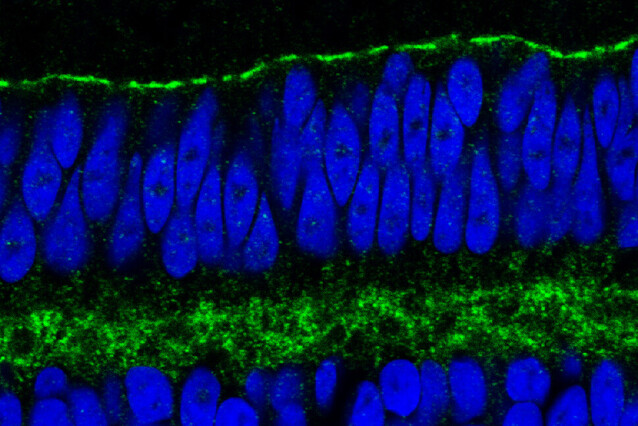CRY2, a component of the bird internal clock

Scientists in the Keays Lab have investigated the expression, localisation, and interaction partners of the cryptochrome CRY2 in the pigeon retina. They found that CRY2 interacts with many major factors involved in the avian circadian clock, and that it may bind the microtubule cytoskeleton of photoreceptor cells. The study is now published in the journal Scientific Reports.
To find their way over long distances, many animals possess an internal compass that detects the Earth’s magnetic field and use it to navigate. Environmental light conditions are thought to influence this extraordinary ability, but the molecular details of the process are yet to be unveiled. The most likely pathway starts with light hitting photosensitive molecules in the eye, which transfer some of their electrons to donor molecules that start a cascade of reactions resulting in a neuronal signal. Magnetic fields can alter the initial electron transfer and the state the molecules are in, which could lead to a change in the animal’s perception of its environment.
Scientists in the lab of David Keays at the IMP – which recently relocated to the Ludwig-Maximilians-Universität in Munich – are working to identify the molecules, cells, and circuits that underlie light-based magnetic sensing in homing pigeons. They have turned to a group of molecules that have long been considered good candidates for magnetic sensing: cryptochromes. Cryptochromes are signalling molecules that can be found across the animal kingdom. Some are sensitive to light, and most play a role in the regulation of circadian rhythms.
Last year, the Keays Lab and collaborators have proposed in the journal Science Advances that one of the cryptochromes found in birds, CRY4, is the most likely candidate for light-based magnetic sensing. While they continue their investigations to confirm their findings, the researchers examined the other cryptochromes in the pigeon’s retina, including poorly studied CRY2.
In the lab’s latest study, now published in the journal Scientific Reports, the scientists pinpointed the localisation, expression patterns, and interaction partners of CRY2, thereby confirming that it is unlikely to contribute to magnetic sensing.
CRY2 and the circadian clock
Animals keep track of daily environmental changes with the help of internal circadian clocks, which allows them to adjust their physiology and behaviour according to the day-night cycle. These clocks require continuous input from environmental cues such as light to keep ‘ticking’ at the right rhythm. They involve a variety of signalling molecules, including cryptochromes.
“Studies of the avian circadian clock have neglected the function of CRY2, and our paper addresses that knowledge gap,” says Spencer Balay, co-first author and student in the Vienna BioCenter PhD Program. “To understand CRY2’s role in the retina, we performed coimmunoprecipitation experiments coupled with mass spectrometry, which allowed us to catalogue the molecules that CRY2 interacts with.”
The researchers found that CRY2 interacted with many mediators of the circadian clock in the retina, which strongly suggests that it contributes to regulating circadian rhythms. “It appears that pigeon CRY2 participates in the circadian transcriptional feedback loop, as seen in other animals,” says Balay.
A possible association with the cytoskeleton
In their study, the scientists measured the abundance of CRY2 in various regions of the retina. They found that CRY2 was particularly abundant in the outer limiting membrane. In some animals, this region of the retina supports the movement of photoreceptors, also called retinomotor movements, away from and towards a light source, which helps the animal maintain circadian rhythms.
These movements involve the contraction and elongation of the retinal cells’ microtubule cytoskeleton. Interestingly, some of the interaction partners of CRY2 identified in this study belong to the microtubule cytoskeleton.
“Current evidence for retinomotor movement in birds is scant, so we will need more experiments to know if CRY2 really contributes to this process,” says David Keays. “We are now confident in saying that CRY2 does not play a role in magnetic sensing, and we will focus future research efforts on CRY4.”
Original publication:
*These authors contributed equally to the study.
Further reading: